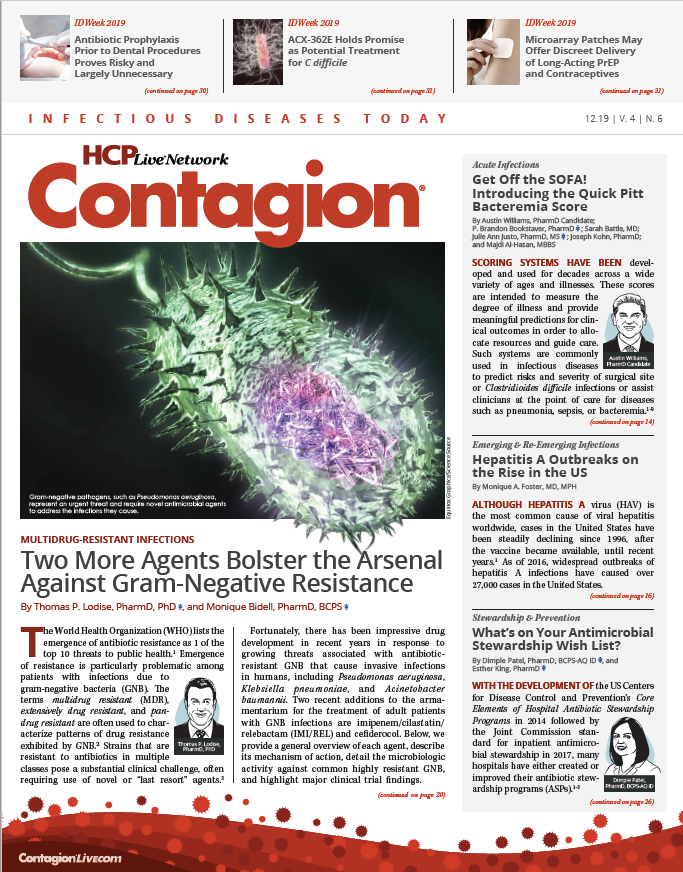Robert F. Poirier, Jr. MD, on the Approval of Lefamulin for CABP
In August, the FDA approved lefamulin (Xenleta) for the treatment of CABP after results from 2 phase 3 studies showed that the novel antibiotic was noninferior to existing treatment options.
In August, the US Food and Drug Administration (FDA) approved lefamulin (Xenleta) for the treatment of community-acquired bacterial pneumonia (CABP) after results from 2 phase 3 studies showed that the novel antibiotic was noninferior to existing treatment options.
Contagion® spoke with Robert F. Poirier, Jr. MD, clinical chief of emergency medicine at Washington University School of Medicine in St. Louis, Missouri, and an investigator on the LEAP 2 trial, to learn more about the antibiotic and what it will bring to clinicians.
Contagion®: How does lefamulin’s mechanism of action differ from other treatment options for CABP?
Rob Poirier, MD: The pleuromutilin class of antibiotics, which lefamulin is part of, has a unique mechanism of action: It selectively inhibits what we call the ribosomal bacterial protein synthesis that occurs and bacteria. This prevents the replication of bacteria itself, thus preventing the spread of the bacteria within the body and within tissues.
The good thing about lefamulin and pleuromutilin class is that it has a different mechanism of action from the 2 other antibiotic classes that we use heavily in pneumonia; namely, the β-lactams and the fluoroquinolones.
Contagion®: Can you discuss the phase 3 LEAP trials that evaluated lefamulin?
Rob Poirier, MD: I’ll begin with the LEAP 1 trial, which enrolled 551 patients with a PORT [Pneumonia Patient Outcomes Research Team] class score of 3 to 4 and looked at the study drug lefamulin first, moxifloxacin plus or minus linezolid. So if the clinician had suspicion that MRSA, or methicillin resistant Staph aureus, was a potential cause with the pneumonia, they could add in the drug linezolid. The good thing with lefamulin is that it is broad spectrum. It has activity against the gram-positive bacteria that commonly cause pneumonia, and most of the gram-negative bacteria that cause pneumonia out there are covered. It looks like it works against Staph aureus, as well.
The participants received IV [intravenous] lefamulin or IV moxifloxacin plus/minus linezolid for 6 doses and then could switch over to the oral formulation of those drugs, so it was either lefamulin or moxifloxacin. It was a double-blind and noninferiority trial. The results showed similar outcomes in both groups of patients tested with the 2 medications.
In LEAP 1, the rates of study discontinuation—stopping the drugs midtreatment due to AEs—were 2.9% for the lefamulin group and 4.4% for the moxifloxacin, so there was, at least by percentage, an increased rate of discontinuation seen in the moxifloxacin group.
I was involved in the LEAP 2 trial and enrolled patients here in the United States. Now, the LEAP 2 trial looked at just the oral formulation of lefamulin; the comparator was again moxifloxacin, and 738 patients were enrolled. It included patients with pneumonia that had a PORT class score of 2, 3, or 4. The patients were treated with 5 days of lefamulin versus 7 days of moxifloxacin.
And so, of course, all patients enrolled in the trial received 7 days of medication—the investigators and the patients were blinded to which antibiotic they were receiving, so all patients received 7 days of treatment. Again, the clinical response rate and adverse effect [AE] profile were similar, and lefamulin was shown to be noninferior to moxifloxacin, which is a drug we commonly use to treat acquired bacterial pneumonia.
Contagion®: What does lefamulin overall bring to the armamentarium for clinicians who are treating CABP?
Rob Poirier, MD: As physicians, we welcome a new antibiotic as long as it’s accessible to patients when we prescribe it to treat CABP, especially an antibiotic that can be prescribed much like we have done with the fluroquinolones. So you can prescribe it as IV initially when needed, and it can be quickly converted to the oral formulation, or you could just prescribe the oral formulation, as well. So that reduces—in our very hectic and busy clinician role—our cognitive load a little bit. It also leads to more patient compliance.
In addition to the global antimicrobial resistance becoming a bigger public health emergency, having a new class of antibiotics for the first time in 20 or 30 years that targets CABP is useful, because all of us have seen resistance developing with our patients, and oftentimes, especially in our complex, chronic patients, we have to go into the medical record, find what antibiotics they’ve been on before, what bacteria they’ve grown out before, and what the resistance patterns are.
I see this class of drugs fitting very seamlessly into our workflow. In fact, it’ll be integrated similarly to how we integrated the fluroquinolones and why that became a top choice or one of our primary go-to medications, at least before all the AEs were published and became known.

